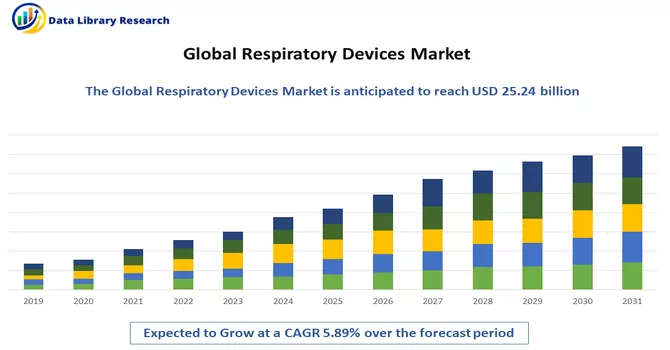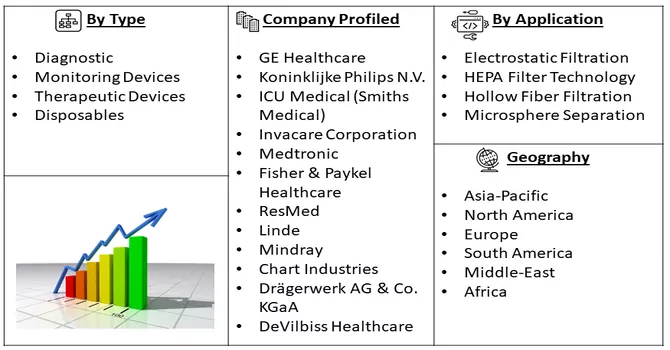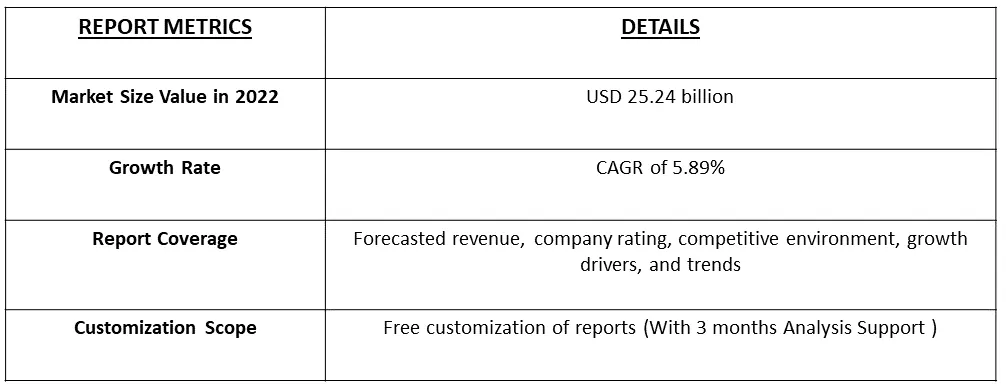The Global Respiratory Devices Market size is expected to grow from USD 25.24 billion in 2022 registering a CAGR of 5.89% during the forecast period (2023-2030).

Get Complete Analysis Of The Report - Download Free Sample PDF
Respiratory assist devices include devices intended to help patients in need of support for breathing, removal of carbon dioxide, and therapy to reduce disuse atrophy of abdominal wall muscles.
The major factor broadly acting as a driving factor includes the increasing prevalence of respiratory disorders, such as COPD, TB, asthma, and sleep apnea, and technological advancements and their increasing applications in a homecare setting.
Smart inhalers are designed to help individuals manage their asthma and COPD better. They can track medication usage and send reminders to users' smartphones. Additionally, they collect data on inhaler technique and environmental factors that can trigger respiratory symptoms, offering personalized feedback to improve treatment outcomes. In recent years, there has been an increasing focus on making respiratory devices more environmentally friendly. This includes using recyclable materials, reducing energy consumption, and minimizing waste in the manufacturing process. Thus, these market trends are driving the studied market growth.
Segmentation:
The Respiratory Devices Market is Segmented
By Type :
Geography :
The report offers the value (in USD million) for the above segments.

For Detailed Market Segmentation - Download Free Sample PDF
Drivers :
The Increasing Prevalence Of Respiratory Disorders, Such As COPD, TB, Asthma, And Sleep Apnea
According to the World Health Organization update in October 2022, the 30 high-TB burden countries accounted for 87% of new TB cases. The WHO Southeast Asian Region had the largest number of new TB cases, with 46% of new cases, followed by the WHO African Region with 23% of new cases, and the WHO Western Pacific with 18%. This increase in TB cases leads to rising demand for respirators, thereby driving the growth of the market. Additionally, according to the CDC update in December 2022, 8.0% of adults aged 18 and over had asthma, and that of children under the age of 18 was 6.5% in 2021. As the number of people with asthma goes up, so does the need for inhalers, which makes the market grow.
Technology and Improvements in artificial intelligence have dramatically changed the healthcare sector
Various market players are investing and innovating in the advancement of respiratory devices. For instance, in November 2022, Xplore Health Technologies launched a first-of-its-kind respiratory muscle training (RMT) device called Airofit Pro. The product comes from a collaboration with Airofit, Denmark. It was one of the first data-driven smart respiratory training systems and is priced at USD 422.74 (Rs 34,990). Airofit Pro personalizes the breathing training experience for users and makes their respiratory muscles stronger, faster, and more efficient. Therefore, with such technological advancements in respiratory devices, the market is expected to grow over the forecast period.
Restraints :
The most significant challenge is the financial burden placed on patients who require respiratory devices
High out-of-pocket expenses for devices, such as ventilators, continuous positive airway pressure (CPAP) machines, and nebulizers, can strain the finances of individuals and their families. The exorbitant cost of respiratory devices can limit access to essential healthcare for patients, particularly those without adequate insurance coverage. This lack of access can result in delayed diagnosis and treatment, leading to worsened health outcomes
The SARS-CoV-2 virus that was responsible for the COVID-19 pandemic severely affected the respiratory system and had a significant impact on people with respiratory illnesses such as asthma, and COPD globally. Hence, the demand for both, respiratory diagnostics and therapeutics devices increased significantly during the peak of COVID-19 in the country which had a significant impact on the respiratory devices market. However, with the vaccination, the cases of COVID-19 decreased significantly in the country which has stabilized the demand for respiratory devices in the country but the emergence of new SARS-CoV-2 strains might have an impact on the market during the forecast period.
Segmental Analysis :
Spirometers Are Projected to Have Significant Share Over the Forecast Period
Spirometers are used in pulmonary tests to measure the air inhaled into and exhaled out of the lungs. They provide a simple way of measuring lung volume and capacity. Spirometers help in diagnosing respiratory diseases, such as asthma, emphysema, bronchitis, and COPD. Furthermore, they can also be used to assess shortness of breath, lung function before surgery, and the effect of medication. This, a wide range of indications of spirometers and advancements in product technologies are driving the segment growth.
The spirometer segment is likely to grow over the forecast period owing to factors such as technological advancements in the field of the spirometer and the high prevalence of respiratory diseases. For instance, as per the article published in February 2022 under the title “Association between obesity and lung function in South African adolescents of African Ancestry”, the study depicted that obesity was associated with airway obstruction in South Africa adolescents of African ancestry and mainly Spirometry was performed to assess lung function.
Furthermore, as per the International Agency for Research on Cancer 2020 report, the number of people affected with Trachea, bronchus, and lung cancer was 8.95 thousand in 2020. This number is estimated to rise to 15.5 thousand by 2040. The increase in prevalence is likely to boost market growth since people tend to utilize respiratory devices to improve their respiratory health. Thus, with the increasing prevalence of chronic diseases and the high adoption rate of respiratory devices, the market is anticipated to grow at significant rates.
Inhalers as Therapeutic Devices is Expected to Witness Significant Growth Over the Forecast Period.
Respiratory inhalers are used to inhale medicines that are an essential part of the treatment for chronic lung diseases. Numerous products deliver medicine directly to the airways such as dry powder inhalers, metered-dose inhalers (MDIs), and soft mist inhalers. The factor that is driving the growth of this segment is the increasing prevalence of respiratory disorders in Spain. In addition, the increasing demand for treatment options for respiratory disorders and the accessibility of well-developed technologies are also contributing to the growth of this segment in Spain.
Furthermore, the increase in air pollution levels in Spain is increasing the cases of respiratory disorders, thereby increasing the demand for respiratory inhalers. For instance, in August 2022, EuroNews.green reported that higher concentrations of nitrogen oxide from increased traffic in Spain and Italy. Being exposed to high amounts of air pollution raises the risk of developing respiratory infections, illnesses, and cancer of the lung, among other health problems. As a result, the rising prevalence of respiratory diseases in Spain is driving up demand for inhalers and fueling the expansion of the market under study. Thus, the segment is expected to witness significant growth over the forecast period.
North America is Expected to Witness Significant Growth Over the Forecast Period
North America holds a healthy market share of the respiratory devices market due to the high burden of COPD, TB, asthma, and sleep apnea in the region. For instance, according to the CDC's 2022 update, 4.6% of adults aged 18 and over had COPD, emphysema, or chronic bronchitis in 2021 in the United States. Because of this, the high number of respiratory diseases in the US is expected to drive market growth over the next few years. In addition, the advanced research and development (R&D) facilities leading to the development of technologically advanced devices, product launches, and partnerships are leading to significant market growth in North America.
According to the NIH's May 2022 update, the United States will spend USD 150 million in 2022 on R&D for respiratory diseases, including COPD (USD 150 million), Asthma (USD 328 million), Tuberculosis (USD 621 million), and Sleep Research (USD 515 million).Therefore, the rising spending on respiratory diseases research is expected to boost the development of innovative respiratory devices in the nation, which is further expected to augment the market's growth during the forecast period.
Additionally, the increasing initiatives, product launches, and strategies by market players in India are also expected to contribute to the market's growth. For example, in December 2021, Vivos Therapeutics started the registration process with Health Canada to make and sell devices for sleep disorders, snoring, and sleep apnea to keep and improve the health of Canadians. Therefore, owing to the above-mentioned factors, such as the rise in respiratory disease and the increase in company initiatives, North America is expected to dominate the market for respiratory devices.

Get Complete Analysis Of The Report - Download Free Sample PDF
The respiratory devices market is moderately consolidated in nature due to the presence of a few companies operating globally and regionally. The competitive landscape includes an analysis of a few international as well as local companies that hold market shares and are well known, including:
Recent Developments:
1. July 2022: Smile Train, Inc. launched the Lifebox-Smile Train pulse oximeter with their long-standing partner Lifebox to scale up access to pulse oximetry for anesthesia and critical care.
2. July 2022: Omron Healthcare announced its latest advancement in the oxygen therapy category with the launch of a portable oxygen concentrator. It is a medical molecular sieve-based concentrator that provides a continuous supply of high-purity oxygen.
Q1. What is the current Respiratory Devices Market size?
The Global Respiratory Devices Market size is expected to grow from USD 25.24 billion.
Q2. What is the Growth Rate of the Respiratory Devices Market?
Respiratory Devices Market is registering a CAGR of 5.89% during the forecast period.
Q3. What segments are covered in the Respiratory Devices Market Report?
By Type and Geography are the segments covered in the Respiratory Devices Market Report.
Q4. Which region has the largest share of the Respiratory Devices Market? What are the largest region's market size and growth rate??
North America region has the largest share of the market . For detailed insights on the largest region's market size and growth rate request a sample here.
Data Library Research are conducted by industry experts who offer insight on industry structure, market segmentations technology assessment and competitive landscape (CL), and penetration, as well as on emerging trends. Their analysis is based on primary interviews (~ 80%) and secondary research (~ 20%) as well as years of professional expertise in their respective industries. Adding to this, by analysing historical trends and current market positions, our analysts predict where the market will be headed for the next five years. Furthermore, the varying trends of segment & categories geographically presented are also studied and the estimated based on the primary & secondary research.
In this particular report from the supply side Data Library Research has conducted primary surveys (interviews) with the key level executives (VP, CEO’s, Marketing Director, Business Development Manager and SOFT) of the companies that active & prominent as well as the midsized organization
FIGURE 1: DLR RESEARH PROCESS

Extensive primary research was conducted to gain a deeper insight of the market and industry performance. The analysis is based on both primary and secondary research as well as years of professional expertise in the respective industries.
In addition to analysing current and historical trends, our analysts predict where the market is headed over the next five years.
It varies by segment for these categories geographically presented in the list of market tables. Speaking about this particular report we have conducted primary surveys (interviews) with the key level executives (VP, CEO’s, Marketing Director, Business Development Manager and many more) of the major players active in the market.
Secondary ResearchSecondary research was mainly used to collect and identify information useful for the extensive, technical, market-oriented, and Friend’s study of the Global Extra Neutral Alcohol. It was also used to obtain key information about major players, market classification and segmentation according to the industry trends, geographical markets, and developments related to the market and technology perspectives. For this study, analysts have gathered information from various credible sources, such as annual reports, sec filings, journals, white papers, SOFT presentations, and company web sites.
Market Size EstimationBoth, top-down and bottom-up approaches were used to estimate and validate the size of the Global market and to estimate the size of various other dependent submarkets in the overall Extra Neutral Alcohol. The key players in the market were identified through secondary research and their market contributions in the respective geographies were determined through primary and secondary research.
Forecast Model
